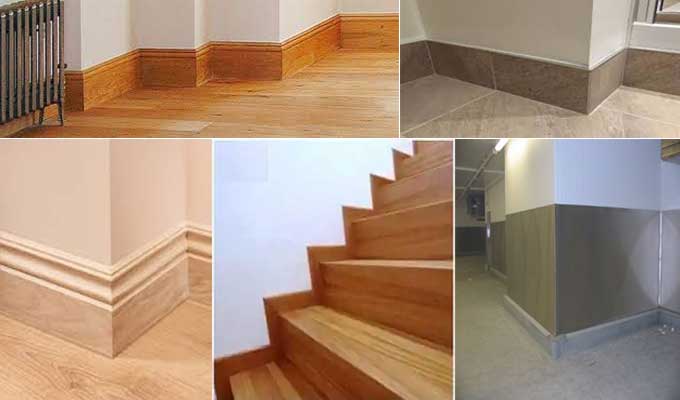
Skirting: How it helps you with your home design & its Types

Tiles that cover the corners or junctions between the floor and wall are call skirting tiles. A seamless transition between the floor and wall gives the impression of a larger room with the skirting boards, as the eye will move from the floor to the wall, and the overall effect will be one of a bigger room.
Types of Skirting Tiles
A wide variety of types of skirting exists, such as metal, wooden, continuous, colored, pencil, plaster, and even cloth skirting.
1. Wooden Skirting
Granite, Marble, Tiles floors are fantastic choice for Wooden Skirting. They enhance the look of the house. Ceilings, walls, and light floors can also finish with wooden skirting. Traditional interiors often have wooden skirting. There are many shapes and sizes of wooden skirting on the market.
2. Pencil Skirting
The use of pencil skirting gives a space a finished appearance. The skirting of this type uses on plain and textured walls.
3. Metal Skirting
The material used for metal skirting is stainless steel. Homemade stainless steel has a rich look and a modern vibe. Lightness creates within the interiors of homes made of this material. There is a major disadvantage to stainless steel skirting in that it is susceptible to scratching.
4. Continued Skirting
As its name implies, continued skirting is a continuation of dark brown skirting boards through the staircase. Skirting boards elevate the whole look.
5. Double Layered Skirting
The two-toned skirt is also called double-layered skirting. Rooms are given an enhanced look by these types of skirting boards.
6. Flush Skirting
It gives the house a seamless aesthetic. Walls and skirting are positioning at the same height at ground level here. Thus, the biggest advantage of these types of skirting is that dust does not accumulate easily as it might in the case of skirting that project out of walls. Having skirts of this type allows the furniture arranges to fit the wall to the fullest extent possible and reduces floor space.
7. Movable Floor Skirting
An innovative type of floor skirting is movable floor skirting. There is a secret locker hidden behind the panel, which is under the cabinet. Because they can open for access to the storage unit behind them, the drawers look like the skirting under the cupboard when closed. Innovative building designs such as this can find in small city houses.
8. Plaster Skirting
An unconventional skirting board style is plaster skirting. It is to add a modern and chic touch to the walls. This skirting adds a sense of interest to the smooth plaster and wooden floors in the wall.
9. Medium Density Fiber Skirting
Medium Density Fiber (MDF) skirting is composed of compressed fibers. You can find it in a wide range of styles and colors. The two main types of MDF skirting are pre-primed and pre-finished.
Pre-primed boards are ideal if you want to decorate and color them later according to your taste. Furthermore, they are inexpensive and are of sufficient durability. The MDF skirting is the perfect choice if you want classic white skirting for the house interior.
10. Bull-nose Skirting
The use of bull-nose skirting gives a house an elegant and modern look. The standard heights of bull-nose skirting boards are between 50mm and 300mm. It requires little maintenance and is easy to clean, which is a major advantage of bull-nose skirting. It matches any interior design style.
Skirting On Kitchen
Kitchens must clean regularly and mopped and swept. A kitchen needs high skirting due to its humid environment and cleanliness requirements.
Skirting on Bathroom
Skirting tiles in the bathroom is the most important aspect of a home's design. The tile floors need to regularly clean by mopping and sweeping. Even the skirting is made of tiles.
Define Skirting Board
In general, skirting board runs along the wall or floor border. This top serves several purposes, including covering uneven edges, protecting the interior wall from wear and tear, and protecting against abrasion. Around 6 inches is the standard height of skirting boards, which is approximately 145mm. Skirting boards are 12mm thick. A Skirting Board with a thickness of 12mm typically uses for pencil-edge, square-edge, and curved-edge profiles.
Your Guide of Choosing the Right Skirting Board
Materials
There are many types of reasons why materials are important. In addition, skirting boards and baseboards are highly durable and of good quality. You can choose from modern, classical, and traditional materials for the purpose of beautification.
To learn more, watch the following video tutorial.
Video Source: Construction Details
Scale & Proportion
You can choose the right types of skirting baseboards for your home according to your room size. If your ceilings are high, you may need to choose taller or higher baseboards.
Maintenance
When choosing a baseboard, think about your daily routine and activity because maintenance entails cleaning it, so your choice of the board should reflect that.


